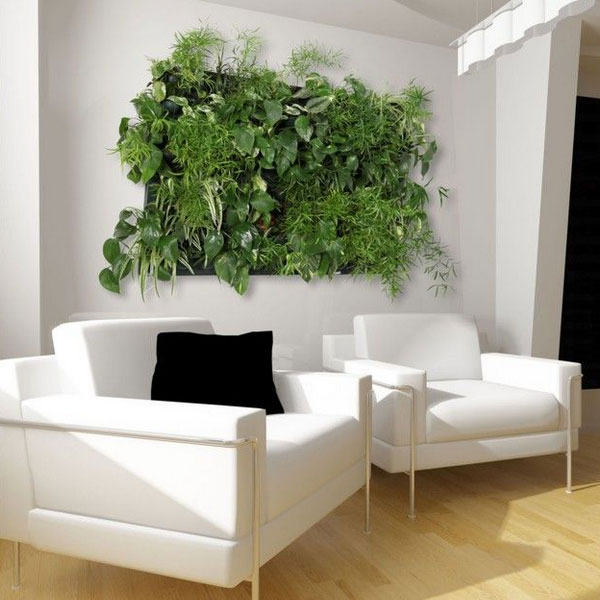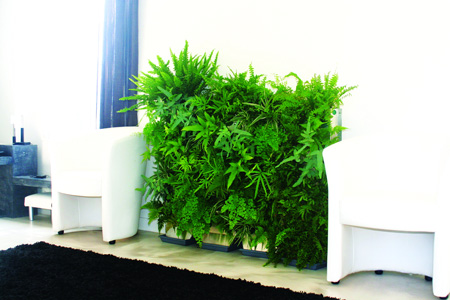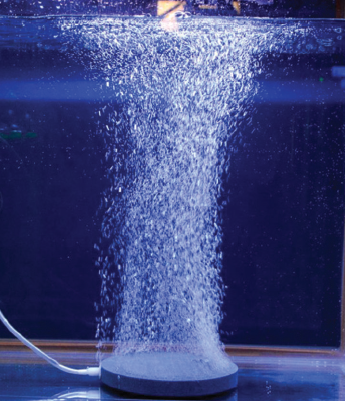GREEN WALLS AND AQUAPONICS
VEGETATION BOARDS
With Flowall and C-Greenyou can compose your own plant walls with fresh plants.


To offer Flowerbox. The brand Flowerbox is specialized in the plant wall with fresh or "stabilized" plants.
|
|
|
Stabilized plants : Plants whose sap is replaced by a substance based on glycerin, perfectly ecological and 100% biodegradable, allowing to keep the plant as it is, for many years, without particular maintenance. |
Culture Indoor also offers the creation of a complete ecosystem for your home. Composed of a plant walland an aquarium this ecosystem works on the principle of aquaponics.
AQUAPONY
What is aquaponics?
Aquaponics is the "symbiosis" of plants and aquatic animals. It is in fact an ecosystem in which 3 types of living organisms intervene: Fish, bacteria, and plants.
3 types of living organisms make up an aquaponics system:
- Fish that enrich the environment with nitrites (toxic for aquatic life) through their excrement.
- Bacteria that transform these nitrites into nitrates. (toxic beyond 100mg/l)
- And the plants which assimilate these nitrates to grow and thus purify the water of this ecosystem.
INTRO
It is in fact an eco-systematic approach in which 3 types of living organisms intervene.
- The fish whose dejecta, rich in nitrogen (ammonium and urea), phosphorus and potassium, are a source of nutrients for the plants. The food provided to the fish enriches the environment in the form of fertilizer.
-The aerobic bacteria that transform ammonia/ammonium and urea from the urine and feces (excrement residues from digestion) of the fish into nitrites (nitrosomonas bacteria) and then into nitrates (nitrobacter bacteria), which can be assimilated by the plants in mineral form (this is the process of nitrification or nitrogen cycle). Potentiate the biological filter by degrading the excretions of the fish which are toxic for them at too high concentrations.
- Cultivated plants purify the aquarium water by assimilation through their roots.
They use the nutrients in mineral form to grow.
Aquaponics is a technique of the future that is increasingly used throughout the world (especially in the United States and Australia) in small commercial operations or by individuals for self-production of food.
In practice, water from the aquarium or breeding tank is pumped into the hydroponic system and then returned to the fish.

The different systems
3 types of hydroponic systems are commonly used in Aquaponics:
- The NFT and floating rafts for commercial operations ("floating rafts" is a technique that we did not develop in the article on hydroponic systems. The plants grow on polystyrene plates floating on the nutrient solution; the roots grow directly in the water)
- The tidal table for small gardens.
It is recommended to start with a low fish population and then gradually increase it and regularly monitor ammonia (NH4), nitrite (NO2) and nitrate (NO3) levels with appropriate colorimetric tests (available in aquarium stores).
It is preferable to colonize the aquarium with fish that are very tolerant to physico-chemical variations (for example goldfish). Do not hesitate to ask for advice in a specialized store. Experience tends to prove that this type of system is viable in the long term, that it requires less control and water changes than a hydroponic system. However, it requires a very good knowledge of the plants and a careful and regular observation of them. The approach here is much more intuitive. To be reserved for those who have a green thumb.
However, there are pH and temperature values that must be respected to guarantee a good assimilation of the plants and the work of the aerobic bacteria: PH between 6.5 and 7. Water temperature: between 21 and 23°. The main issue is to find the right balance between the fish population, the food provided, the bacterial population and the cultivated vegetation. A nitrogen deficiency (yellowing of the leaves developing from the bottom of the plants) will be a sign of an underpopulation of fish and/or a lack of food or a poor bacterial work.
On the other hand, high nitrite and nitrate levels indicate that the plant filter is inefficient and that the plants' metabolism is insufficient to clean the water of excrement or that the bacteria are not working properly.
It is recommended to start with 1 cm of fish per 4 liters of water. Once the system is well installed (at least after 2 months), it can be increased to 3 cm per 4 liters.
The aquatic food cycle
Innovative cultures require knowledge and mastery of the natural processes that govern any ecosystem. If the main principles are equivalent, there are differences in the various adaptations to ecosystems. Let's take a look at the "aquatic" ecosystem that governs aquaponic cultivation techniques
Prerequisite
It is necessary to clarify what an ecosystem is and its composition.
The ecosystem is an ecological unit made up of a natural environment (the biotope), all its living and non-living components (the biocenosis).
The biotope is a geographical area offering constant or cyclical climatic and ecological conditions to the species living there in equilibrium, for what concerns us: the so-called fresh water (compared to salt water and not to its chemical composition).
The biocenosis is the whole of the living and non-living components of a biotope. These living beings usually live in niches, areas: the interfaces, places of many permanent exchanges related to biological cycles or migration of organisms.
If each ecosystem is particular, it should be noted that many of them offer common characteristics such as the terrestrial ecosystem, the marine ecosystem, the aquatic ecosystem ...
In the natural aquatic ecosystem, there are three active interfaces:
- The water/sediment interface: This is the entire bottom of the basin from the contact line with the land.
- The water interface
- The air/water interface
The global functioning of the aquatic ecosystem follows a relational cycle that we call: food cycle or trophic cycle. Different cycles are involved in the symbiosis of organisms in aquaponics.
Cyclic stages
The "aquatic" food cycle has three main stages: the consumption stage, the decomposition stage and finally the production stage. The actors of this "play" are first heterotrophic beings, then autotrophic beings. All these living beings can be either macroscopic or microscopic.
All intervene and are interdependent. A biocenosis (the whole of the living beings populating a biotope) is balanced when each of the species present finds its niche, its place in the whole.
| A- The stage of consumption | B- The stage of decomposition | C- The production stage |
|
Actions of heterotrophic beings: It is the privileged place of animals, heterotrophic beings. The heterotrophs are beings which to live, to restructure, consume which of the plants (herbivores), which of other animals (carnivores) to see both (omnivores). We repeat, they can be macroscopic or microscopic. After having consumed, i.e. transformed the organic matter that was swallowed and extracted the elements necessary for their vital needs, they reject residual organic matter. These are the "exogenous inputs". |
Actions of heterotrophic beings Stage B1: All suspended matter will undergo various stages of decomposition at this stage, the purpose of which is to break down the matter into smaller and smaller elements until it reaches a size accessible to bacteria. This work is carried out by the "detrivores" which are: fungi, insects, crustaceans →Stages B2: →finally by heterotrophic bacteria. Heterotrophic bacteria being specialized to transform either lipids, carbohydrates or even protids. These heterotrophic bacteria make the transition between heterotrophic actions and autotrophic actions Because they transform organic matter into inorganic matter. Stage B3: Action of autotrophic bacteria Find the deficiencies of plants on Culture Indoor. |
The plants (plants, algae) consume the inorganic matter prepared by the autotrophic bacteria (nitrates, phosphates ... Trace elements ...) to make organic matter, through photosynthesis. Plants that will then be consumed by herbivores and omnivores ... the loop is closed. In the next article, we will focus on bacteria, the keystone of life on earth. |
Water heating
The temperature of the tank is important for fish, cold-blooded animals, because the temperature of their body depends directly on the temperature of their living environment. It has a direct impact on their metabolism, and therefore on their life expectancy. What you need to know is that they can't stand a temperature higher than 38°C. The reason is that the solubility of gases in water, which depends on the temperature, decreases when the temperature increases. The aquarist must therefore regulate the temperature of the water, using a heater. There are "two-in-one" devices that combine the heater and the thermostat in one object the immersion heater. The choice of the power of the device is made according to the following rule :
- 1 W/L if the difference between the room temperature and the water temperature is less than 10°C,
- 1.5 W/L if it is less than 15°C,
- 2 W/L if it is less than 20°C.
The fact that the heater is coupled with a thermostat allows it to be turned off automatically when the desired temperature is reached. It is therefore unnecessary to switch it off when the temperature is higher, since the temperature of the water is not the result of the action of the immersion heater, but of the ambient temperature.
Turning off an immersion heater carries a significant risk as the temperature is likely to drop sharply at night, which can be a shock to the fish. Never leave an immersion heater turned on out of the water. Find immersion heaters in the Irrigation section

Aquariums and photos by Amano Takashi.
WATER CONTROL
Water quality
It is best not to use any chemicals commercially available under the name of pH+ or pH-. They can unbalance the water qualities and be harmful to fish. The same applies to resins, which release various undefined substances (often sodium) into the water.
Increasing the pH (basic)
The most effective and least risky way is to add limestone to the water. For this, there are two solutions:
- With baking soda in very small doses: about
1 teaspoon for 50 L of water, the pH should stabilize at 8.
- With crushed oyster shells or coral sand, which you will insert in your filter, in a sticky or a net, in order to be able to remove them more easily. Check the pH regularly after this manipulation.
Lowering the pH (acidifying)
Several recipes can be used, and are sometimes more effective when combined. The first thing to do is to lower the water hardness (in case the water is too hard, which is usually the case when the pH is too high), to facilitate the lowering of the pH. The easiest way to do this is to use "osmosed" water(filtered with an osmosis machine) during the partial water renewal. Once the water is softened, several solutions are available:
- Adding peat to the filter, under the gravel, or in the bucket or tub that you use for water changes. This method softens the water but has the disadvantage of (temporarily) discoloring it, which is not appreciated by everyone.
- Diffusion of CO2 in the aquarium.
- Adding acid: This method works well, but it is reserved for aquarists and experienced chemists. Acid should be added in small amounts over several days to avoid carbonate precipitation.
PH in aquarium keeping
Aquatic life is only possible between pH 4.0 and 9.0, but most often the values are between 6.0 and 8.0 in fresh water and 8.1 to 8.3 in salt water. At night, plants and fish breathe, producing CO2 which acidifies the water when it is weakly buffered. The pH then drops slightly. During the day, plants use the CO2 and produce oxygen, this is called photosynthesis. The absorption of CO2 by the plants increases the pH slightly. A hard or salty water limits better the variations of the pH. In the long term, we can sometimes observe an increase of the pH in well planted aquariums, the CO2 used by the plants disappearing gradually. It is then necessary to supply CO2 to the plants thanks to various systems (bubblers, tablets, electro-valve...). Find the pH testers in the "controls" section.
Water oxygenation
The air pump (or bubbler) is connected to a diffuser (made of wood, ceramic or porous stone) by an air hose. The most sophisticated pumps offer several different outlets to supply several diffusers, with an air flow adjustment system. The use of a bubbler in a tank has several direct and indirect effects on the water in the tank, effects that make it useless, or even downright harmful when you have plants in the aquarium. The bubbler is useless in tanks containing plants, as the amount of oxygen they provide is necessary for the survival of the fish. In addition, it creates eddies that remove CO2 from the water, which is essential for good plant growth, while increasing the pH of the tank. These three effects indicate that in a planted tank, the use of a bubbler is to be avoided, at least if this use is permanent. In tanks with little or no planting, the use of a bubbler and the consequences it has on the balance of the tank can be advantageously replaced by the following trick: create a slight eddy at the surface by directing the head of the filter towards the surface. On the other hand, it is important to have a bubbler available because it can be a great help in certain situations:
- In case of a pollution peak (NO2 > 0), the addition of a bubbler helps to promote the oxidation reactions that transform nitrites into nitrates. This measure, in addition to a few others, allows a quick return to an acceptable situation for the fish and helps them to endure this peak which can be fatal for them.
- In case of high temperatures, the use of a bubbler can reduce the temperature of a tank by a few degrees, in the same way as the use of a fan. Above all, do not pour cold water because of the impact on the fish.
- When fish spend a lot of time on the surface sucking air, there is a lack of oxygen in the tank. Using a bubbler will quickly remedy this situation.
You will find this equipment :
- Immersion heaters in the "irrigation" section
- PH testers in the "controls" section
- Air pumps and bubblers in the "irrigation" section
- Water pumps in the "irrigation" section
AQUARIUM LIGHTING
Light is a very important factor in aquarium keeping. It is important to choose the right lighting according to the needs of the aquarium's occupants (fish and plants).
Positioning of the lighting
In a natural environment, light comes from above. This principle must be respected in the aquarium. Too much natural light from the front or side of a tank (from a window) will cause algae growth. Artificial lighting is therefore mandatory. A reflector will allow you to make the most of the light emitted.
Duration of the lighting
Tropical plants have a lighting duration of 12 hours. The maximum duration of lighting is 15 hours, beyond that the plants and fish need a rest period. The lighting time should be continuous. As with the cultivation of plants, splitting up the light disrupts the rhythm of the fish and plants. A low light intensity cannot be compensated by a longer light duration. The use of a timer allows the lighting to be switched on and off automatically at fixed times.

Light intensity
Not all plants have the same light intensity requirements. To determine the light intensity of an aquarium with fluorescent tubes, the following rule applies
| 1W for 1 liter of water | 1W for 2 liters of water | 1W for 3 liters of water | 1W for 4 liters of water |
| very bright light | intense light | medium light | low light |
Neon tubes
The tubes used in aquariums are not the same as those used in industry or at home. Indeed, the aquarium tubes have a spectrum adapted to plants and fish. It is the fluorescent powder that modifies the spectrum. The ideal colors to promote plant growth (photosynthesis) are red, orange and blue. The horticultural tubes have a reinforced spectrum in these colors. It is agreed by all aquarists to change the fluorescent tubes every six months because their performance decreases with age, causing a slowdown in plant growth and promoting the appearance of algae. You should not change all the tubes at the same time but keep a minimum interval of one month between each change of tube in order to limit the variations.
MH lamps
When the aquarium is deeper than 80 cm, a more powerful lighting is needed: metal halide lamps. The life span of these lamps is about 6000 hours which corresponds to a little more than one year of lighting at a rate of 12 hours per day. MH lamps are very hot, so a certain distance must be respected (40 to 70 cm).
Superfish is the brand CIS Products dedicated to the lighting of your aquariums. Bulbs dedicated to lighting your aquariums from 250W to 1000W.
Find all our advice for your indoor culture:
- Tips for indoor aquaculture : Light
- Advice for indoor aquariums : Air
- Growing tips for indoor aquariums : The Substrate
- Growing tips for indoor plants : Water and fertilizers
- Growing tips for indoor plants : Germination and Cutting
- Growing tips for indoor plants : Growth
- Growing tips for indoor plants : Flowering
- Growing tips for indoor plants : The growing room
- Tips for indoor growing : Systems
- Growing tips for indoor plants : Water control
- Growing tips for indoor plants : Aquaponics


